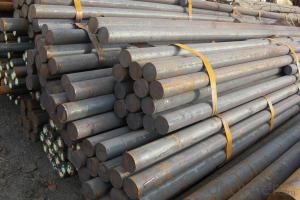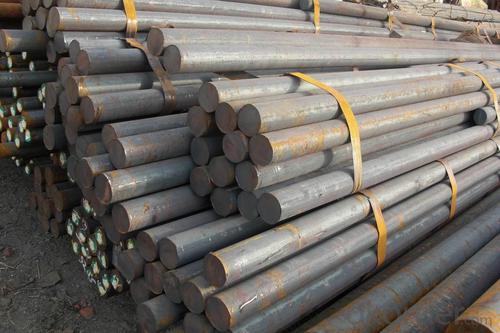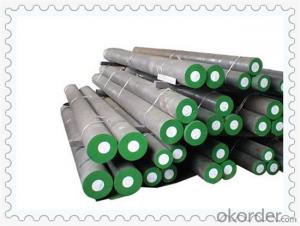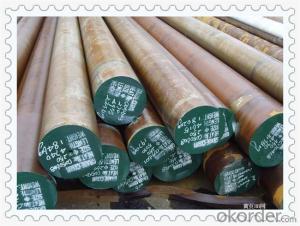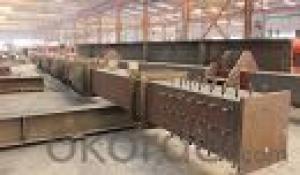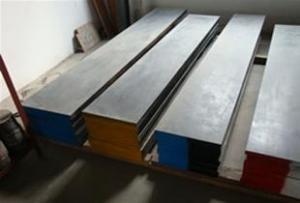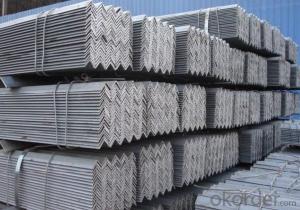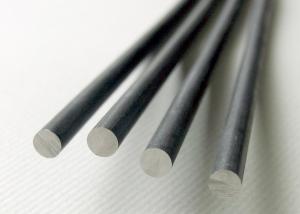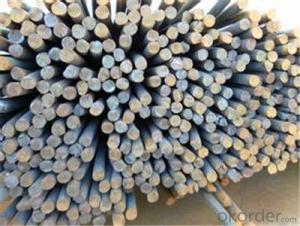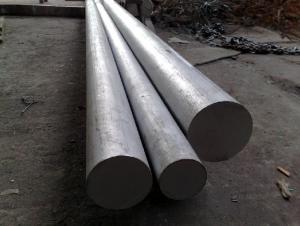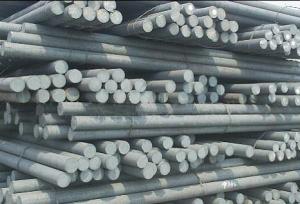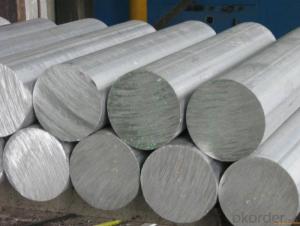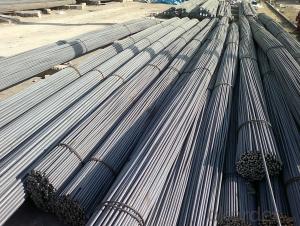Good Quality Round Steel
- Loading Port:
- China Main Port
- Payment Terms:
- TT OR LC
- Min Order Qty:
- -
- Supply Capability:
- -
OKorder Service Pledge
OKorder Financial Service
You Might Also Like
Specifications
1.EF+EAF+LF+VD+ESR
2.Competitive price
3.ISO&IQNet certificate
4.Excellent hardenability
5.P/S lessthan 0.020
Cold Work Tool Steel 1.2379, Alloy Steel Round Bars 1.2379, Din 1.2379 Steel Rod
Chemical composition 1.2379 round bar
| Equivalent grades | ||||
| GB | DIN | AISI | JIS | BS |
| Cr12Mo1V1 | 1.2379 | D2 | SKD11 | BD2 |
| Chemical composition | |||||||
| C | Si | Mn | Cr | P | S | V | Mo |
| 1.50-1.60 | 0.10-0.40 | 0.15-0.45 | 11.50-12.50 | 0.03MAX | 0.03MAX | 0.90-1.10 | 0.60-0.80 |
Specification
Round bar | Diameter (mm) | Length (mm) |
|
50~500 | 2000~5800 |
| |
plate/sheet | Thickness (mm) | Width (mm) | Length (mm) |
20~400 | 80~1000 | 2000~5800 |
Steel Surface
| Steel Sharp | Surface treatment |
| Round bar | Black/Grinding/Polished/Peeled/Turned |
| steel plate | Black/Milling/Machined |
Characteristic 1.2379
1.High hot strength and hardness.
2.Good toughness and abrasion resistance.
3.Heat treatment deformation small
Finished goods condition: 1.2379 hot forging/hot rolling + annealing/normalizing +
tempering/quenching + tempering/any conditions based on the customer's requirement
Surface conditions: rough machining/fine machining/based on the customer's requirement
Ultrasonic inspection: 100% UT acco to En1921D/d or based on the customer's requirement
- Q: Can steel round bars be used for making molds?
- Steel round bars can be used for making molds, but it may not be the most common or ideal choice of material. Steel round bars are typically used for structural applications or as support components. When it comes to making molds, other materials such as silicone, aluminum, or even specific types of steel molds are typically preferred. These materials offer better heat resistance, flexibility, and ease of use for molding purposes. That being said, if the steel round bars are properly machined, shaped, and treated, they can still be used to create simple molds for certain applications. However, it is important to consider the specific requirements of the mold, including the material being molded, the temperature and pressure conditions, and the desired finish of the final product, before deciding on the use of steel round bars.
- Q: How are steel round bars tested for tensile strength?
- Steel round bars are tested for tensile strength using a method called a tensile test. This test measures the resistance of a material to a stretching force, and it is commonly used to determine the mechanical properties of metals. To perform a tensile test on a steel round bar, a sample is taken from the bar in the form of a cylinder or a rectangular shape. The sample is then prepared by removing any surface imperfections or irregularities. Next, the sample is inserted into a testing machine called a tensile testing machine. The machine consists of two grips, one at each end, which securely hold the sample. One grip is fixed while the other is movable. The testing machine applies an increasing force to the sample, causing it to stretch until it eventually breaks. As the force is applied, the machine measures the amount of force required to stretch the sample and records the elongation or deformation of the sample throughout the test. The test results are used to calculate various mechanical properties of the steel round bar, including its ultimate tensile strength. This is the maximum amount of stress the material can withstand before it breaks. Other properties such as yield strength, elastic modulus, and elongation at break can also be determined from the test. Tensile testing is a critical method for determining the quality and suitability of steel round bars for various applications. It helps ensure that the material meets the required specifications and can withstand the expected loads and stresses in its intended use.
- Q: What are the differences between the products made of wrought round steel and hot rolled round steel and tested by mechanical testing after heat treatment?
- In comparison, the general longitudinal performance of hot rolled round bar is better than that of transverse or tangential direction, and the difference between the two values is obvious. The banded structure is more obvious in the longitudinal microstructure, and the deformation of non-metallic plastic inclusions is more obvious
- Q: Are steel round bars suitable for electrical conductivity?
- Steel round bars are generally not recognized for their ability to conduct electricity. While steel is a proficient conductor of heat, its electrical conductivity is relatively inferior when compared to metals like copper or aluminum. The primary reason for this disparity is that steel is primarily composed of iron, which is known for its inadequate electrical conductivity. However, by incorporating specific alloying elements like chromium or nickel, the electrical conductivity of steel can be enhanced. This improvement allows steel to be more suitable for applications that necessitate electrical conductivity. Nevertheless, if a high level of electrical conductivity is of utmost importance, materials like copper or aluminum are typically favored over steel round bars.
- Q: What are the different types of steel round bars used in the automotive engine components?
- Automotive engine components rely on various types of steel round bars, each possessing unique properties and applications. 1. Carbon Steel Round Bars: The most prevalent variant, carbon steel round bars, display exceptional strength and durability. Their versatility allows them to be employed in manifold applications such as crankshafts, connecting rods, and camshafts. They excel in withstanding elevated stress levels and extreme temperatures. 2. Alloy Steel Round Bars: By introducing alloying elements like chromium, nickel, and molybdenum to carbon steel, alloy steel round bars enhance their strength, toughness, and resistance to wear. They find common usage in automotive engine components like gears, shafts, and bearings, which necessitate high strength and the ability to resist wear and fatigue. 3. Stainless Steel Round Bars: Automotive engine components that encounter corrosive fluids or environments benefit from the corrosion-resistant properties of stainless steel round bars. Valves, pistons, and exhaust systems are among the applications where stainless steel round bars are frequently employed. 4. Tool Steel Round Bars: Tool steel round bars are renowned for their remarkable hardness, abrasion resistance, and superior toughness. They are extensively utilized in automotive engine components involved in cutting or shaping processes, such as cutting tools, dies, and punches. 5. High-Speed Steel Round Bars: High-speed steel round bars are engineered to endure high temperatures while maintaining hardness and cutting efficiency at elevated speeds. Drills, milling cutters, and reamers in automotive engine components often benefit from high-speed steel round bars. It is crucial to highlight that the choice of steel round bar for automotive engine components depends on the specific application, performance requirements, and cost considerations. Automotive manufacturers meticulously select the appropriate steel grade to guarantee optimal performance and durability of engine components.
- Q: How do you identify the grade of a steel round bar?
- The grade of a steel round bar can be identified through several methods. One way is to check the markings or labels on the bar itself. Manufacturers often stamp or engrave the grade directly onto the surface of the bar. These markings typically include information such as the grade designation (e.g., 304, 316, 4140), which represents the specific alloy composition, and may also include additional details such as the heat or lot number. Another method is to refer to the mill test certificate (MTC) that accompanies the steel round bar. The MTC provides comprehensive information about the composition, mechanical properties, and other relevant specifications of the material. The MTC is usually issued by the steel mill or supplier and can be requested upon purchase. Moreover, visual inspection and physical testing can help identify the grade of a steel round bar. Visual inspection involves observing the bar's appearance, texture, and color. Different grades of steel may exhibit distinct characteristics, such as a shiny or matte finish, specific surface treatments, or variations in color due to different alloying elements. Physical testing methods, such as tensile or hardness testing, can provide further confirmation of the steel grade. These tests measure the mechanical properties of the material, such as its strength, ductility, and hardness. By comparing the test results with known standards and specifications for different steel grades, one can determine the grade of the round bar. In summary, to identify the grade of a steel round bar, one can check for markings on the bar, refer to the mill test certificate, visually inspect the bar, and perform physical tests to assess its mechanical properties.
- Q: What is the average cost of steel round bars?
- The average cost of steel round bars can vary depending on various factors such as the size, grade, and market conditions. Generally, the price of steel round bars ranges from $0.50 to $5 per pound. However, it is important to note that these prices are approximate and can fluctuate based on the specific requirements and location of the purchase. Additionally, additional costs such as transportation, processing, and any applicable taxes should also be considered when determining the overall cost. It is recommended to consult with local suppliers or conduct market research to obtain the most accurate and up-to-date information on the average cost of steel round bars in your specific region.
- Q: How do steel round bars compare to other types of steel products?
- Steel round bars are a versatile and widely used steel product that has distinct advantages over other types. Firstly, their circular cross-section provides excellent strength and stability, making them ideal for load-bearing applications in construction, automotive, and manufacturing industries. Compared to steel plates or sheets, steel round bars offer greater customizability. They can be easily cut, drilled, and machined to meet specific requirements, allowing for complex shapes and precise dimensions. This adaptability makes them preferred in engineering and fabrication projects. In addition, steel round bars have exceptional tensile strength and durability, ensuring long-lasting performance even in demanding environments. They are highly resistant to corrosion, impact, and wear, making them suitable for outdoor or high-stress applications. Their durability also contributes to cost-effectiveness, as they require minimal maintenance and have a lengthy lifespan. Another advantage is the wide range of grades and alloys available for steel round bars. This allows for the selection of bars with specific properties, such as increased hardness, heat resistance, or enhanced machinability. The availability of various grades ensures that steel round bars can be tailored to meet specific performance requirements, making them a versatile choice for engineers and designers. In conclusion, steel round bars offer several advantages over other steel products. Their circular cross-section provides strength and stability, while their customizability allows for precise shaping. They are durable, resistant to corrosion and wear, and available in various grades, making them suitable for a variety of applications across different industries.
- Q: Are steel round bars suitable for use in the mining industry?
- The mining industry finds steel round bars to be suitable for use. These bars are renowned for their strength and durability, making them an ideal choice for heavy-duty equipment and machinery in mining. They can be utilized in various ways, such as shafts, support beams, and structural components in underground mines, open-pit mines, and processing plants. The steel round bars have the capability to withstand high loads and pressures, enabling them to thrive in harsh mining environments. They possess excellent tensile strength and can endure extreme temperatures, resulting in resistance to wear, abrasion, and impact. This is especially valuable in mining operations where equipment is subjected to heavy loads, vibrations, and constant movement. Furthermore, the steel round bars are easily weldable, fabricated, and machined to meet specific requirements, making them versatile and adaptable for a wide range of mining applications. They can be customized in terms of size, length, and shape, ensuring a perfect fit for various mining equipment and structures. Beyond their strength and versatility, steel round bars also offer cost-effectiveness and long-term value. They have a long lifespan, require minimal maintenance, and can withstand the harsh conditions typically encountered in mining operations, reducing the need for frequent replacements or repairs. Overall, steel round bars are a reliable and suitable choice for the mining industry due to their strength, durability, versatility, and cost-effectiveness. They provide the necessary support and structural integrity required for mining operations, ensuring the safety and efficiency of the industry.
- Q: What are the different testing methods for steel round bars?
- Steel round bars undergo various testing methods to assess their quality and performance. These methods encompass: 1. Tensile Testing: This method determines the strength and elasticity of steel round bars by subjecting them to force until they fracture. It measures the maximum load the bars can endure, helping ascertain their ultimate tensile strength, yield strength, and elongation. 2. Hardness Testing: To evaluate the resistance of steel round bars against indentation or scratching, hardness testing is employed. It includes tests like Rockwell, Brinell, and Vickers, which provide insights into the material's ability to withstand wear, deformation, and surface damage. 3. Charpy Impact Testing: This testing measures the toughness and resistance to brittle fracture in steel round bars. It involves striking notched samples with a pendulum and measuring the energy absorbed during fracture. This test is vital in assessing the material's behavior under sudden impact or dynamic loading scenarios. 4. Ultrasonic Testing: High-frequency sound waves are utilized in this non-destructive testing method to detect internal flaws or defects in steel round bars. It identifies cracks, inclusions, or voids that might compromise the material's structural integrity. 5. Magnetic Particle Inspection: This method identifies surface cracks or defects in steel round bars by magnetizing the material and applying iron particles or magnetic ink. Any cracks or flaws cause a leakage of magnetic flux, making them visible under suitable lighting conditions. 6. Visual Inspection: This basic yet essential method involves visually examining the surface of steel round bars for any visible defects such as pits, scratches, or irregularities in shape or dimensions. 7. Chemical Analysis: By analyzing the composition of steel round bars and measuring the percentage of various elements present, chemical analysis ensures that the material meets required specifications and is suitable for its intended application. In summary, a combination of these testing methods is employed across industries like construction, manufacturing, and engineering to guarantee the quality, performance, and reliability of steel round bars.
Send your message to us
Good Quality Round Steel
- Loading Port:
- China Main Port
- Payment Terms:
- TT OR LC
- Min Order Qty:
- -
- Supply Capability:
- -
OKorder Service Pledge
OKorder Financial Service
Similar products
Hot products
Hot Searches
Related keywords
